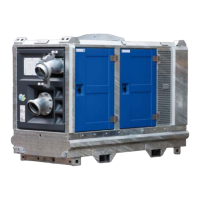BA series pumps
Pump unit installation 1401
5.5
5.5 Piping guidelines – general
The piping must comply with the following guidelines:
– Select the diameter and length of the suction and pressure pipes as well as those of any additional
components such that the inlet pressure remains above the minimum allowable value. The operating
pressure must not exceed the maximum allowable value.
The power rating of the installed drive system must be sufficient. NPSH graphs are available
on request.
– The diameters of the pipes must be equal to or greater than the connection sizes on the pump.
– See the specification sheet for the particular pump or pump installation to obtain the prescribed pipe
diameters.
– If possible, the transition between various pipe diameters must be made with a transition angle of
approx. 8 degrees.
– The pipe must be properly aligned with the pump connection.
– It must be possible to connect the flanges of the pipes and pump together without putting any of the
parts under stress.
– In the case of vibration and/or hot liquids, install expansion elements in the pipes.
– Support the pipes directly in front of the pump. The weight of the pipes and fittings may not be
supported by the pump.
– Install shut-off valves in the suction and pressure pipes as close as possible to the connection
flanges in order to allow isolation of the pump for maintenance and repair work. The shut-off valves
must be of a type that allows straight-line flow, such as gate or globe valves. The internal diameter of
the shut-off valve must be the same as that of the pipe.
– If there is a possibility that a backflow of liquid could cause the pump to turn in the opposite direction
when stopped, a non-return valve must be placed in the piping to prevent this.
– Install measurement instruments in the piping for monitoring during operation.
– If applicable, connect the pump unit to a suitable safety system. This is left to the judgement of the
designer of the installation.
– Insulate or shield hot pipes.
– Observe specific regulations that pertain to the suction and pressure pipes.
– Thoroughly clean all parts that come into contact with the transported liquid before putting the pump
unit in operation.
Note
When pumping viscous liquids, there can be significant pressure losses in the suction and pressure
pipes. Components placed in the piping system, such as shut-off valves, bends, suction strainers, filters
and foot valves, will make the pressure losses greater.
WARNING
The designer of the installation that includes the pump unit is responsible for
installing the pump unit correctly.
Failure to follow the guidelines can result in an excessive load on the pump unit
and/or piping, which can cause severe damage to the pump unit and/or piping.
Possible leakage of liquid can lead to a dangerous situation.

